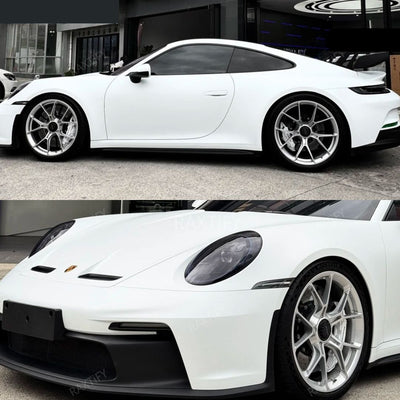
Darkest legal tint for Cars in Virginia
- Windshield: Non-reflective tint is allowed above the manufacturer’s AS-1 line (or top 5 inches).
- Front Side windows: Must allow more than 50% of light in.
- Back Side windows: Must allow more than 35% of light in.
- Rear window: Must allow more than 35% of light in.
Darkest legal tint for SUV and Vans in Virginia
- Windshield: Non-reflective tint is allowed above the manufacturer’s AS-1 line.
- Front Side windows: Must allow more than 50% of light in.
- Back Side windows: Any darkness tint can be used.
- Rear window: Any darkness tint can be used.
Please note: The data must be reviewed according to the accuracy rate and completeness alongside adequacy and currency standards. Lawyers and law firms do not include our organization while we refrain from providing legal advice. Consultation with a professional lawyer or relevant expert for legal advice is necessary according to our recommendation..
Front And Back Side Windows
Tinting of side windows in vehicles has varying regulations depending on the type of vehicle and position of the window on the vehicle. In passenger vehicles, front-side windows should allow a minimum of at least 50% of light through for better visibility. The rear-side windows are allowed to be much darker, allowing in as little as 35% of the light, offering more privacy and protection from the sun.

Like SUVs and vans, other multi-purpose vehicles require the same rules for the front-side windows--50% VLT. The rear-side windows can have any VLT without restriction to allow owners flexibility in providing additional privacy or UV protection if needed.
Fully understanding these regulations will ensure that one is always on the right side of the law locally, while making the most of the benefits that window tints deliver in terms of comfort, privacy, and protection. Understand the limits that will be helpful for those who seek either to make their car a bit more stylish or functional. RAXTiFY is known for a variety of high-class tints at your service.
Windshield
Virginia State's windshield tint law prohibits any tinting on the entire windshield area, regardless of the percentage level of VLT. However, drivers are permitted to apply non-reflective tint above the AS-1 line, which is about 5 to 6 inches from the top of the windshield. The thinking here is that clear vision must be available for safety, but a little sun shade and glare reduction need to be granted the driver.
Rear Window
In Virginia, passenger vehicles' rear windows can be tinted allowing at least 35% VLT. However, multi-purpose vehicles can use any VLT on the rear windows.
Headlight Tint Laws
Headlight tinting is prohibited in Virginia owing to safety reasons. These can be achieved through the use of film or spray-on products for headlight tint; however, they have been banned in Virginia as they reduce the quantity of light thrown on the roads. This low visibility can lead to hazardous driving conditions for other road users and the driver of the car. Moreover, headlight tint limits the driver's visibility and heightens the risk of accidents. As such, it is advisable to adhere to the state statutes for safe driving experiences.
Taillight Tint Laws
One is not allowed to drive in Virginia with tinted tail lights. This means that all taillights ought to have the standard red color they originally come with from the factory. In this regard, other drivers will not have a hard time seeing the vehicle in front of them and can promptly act in a bid to avoid any accidents. Indeed, having standard red shading on the taillights guarantees clear visibility; hence, safe motoring. It is a very crucial law that vehicle owners should follow, not only to prevent fines but also for the safety concerns of all people using the road.
Tinted License Plate Cover Laws
State law in Virginia prohibits license plate covers that tint or color anything. Clear covers are allowed; they just cannot obscure any portion of the license plate. This means not blocking numbers, letters, or any other important information. A compliant cover ensures your car stays within legal parameters and doesn't receive fines.
Virginia Window Tint Laws for Trucks and SUVs Legally
Like most states, the window tint laws for trucks, SUVs, and vans in the State of Virginia are also the same as those on passenger sedans. Nevertheless, such laws can be altered based on how the truck or SUV is used. For passenger trucks and SUVs, the front-side windows shall permit at least 50% VLT. The back-side windows and rear windows in passenger trucks and SUVs shall allow at least 35% VLT.

Full tinting of windshields is not allowed on pickup trucks, SUVs, whether passenger or multi-purpose vehicles. The only place tinting can be allowed is above the AS-1 lines. Secondly, there are special requirements concerning drivers who have medical exceptions.
A good understanding of the nuances will serve to ensure that tinting conforms to the Virginia tint law, to avoid fines and ensure safe driving. For any medical needs, it is good to ask what local authorities consider permissible and to ensure your vehicle fits within those state guidelines.
Window Tint Violations in Virginia
In Virginia, a first-time offense of illegal car window tint is charged as a Class 3 misdemeanor. The fines usually range up to $500 in monetary form but with no jail time. A second and subsequent offenses for the same motor vehicle turn into a Class 2 misdemeanor. This is classified as a more serious crime, and the penalty is punishable by up to six months in jail, a fine of up to $1,000, or both, if severe.
It is highly crucial to avoid these penalties, and that means one must keep in check that his window tint is in line with the set laws by Virginia. No illegal window tint can be so major it's worth such serious consequences. Keep the knowledge right at the fingertips and follow the rules to avoid being in violation for a second time.
Additional Research
The enforcement of current Virginia window tint legislation depends on your knowledge of state requirements for operating your vehicle. The Virginia Department of Motor Vehicles maintains numerous online resources which deliver current guidelines regarding these rules. Updating your knowledge about these rules supports your avoidance of penalties while guaranteeing your vehicle stays compliant with Virginia state regulations. For the most accurate and current details, regularly check the official Virginia DMV website.
FAQ
Q1. What are the tint laws in Virginia?
A: In Virginia, tinted windows must allow at least 50% of light in.
Q2. Can you have tinted front windows in Virginia?
When you can have tinted front curtains in Virginia, only if they permit at minimum 50 percent of light to pass through.
Q3. Are there medical exemptions for tinted windows in Virginia?
Yes, those with appropriate medical circumstances would have them needing less sun exposure.
Q4. Is reflective tint legal in Virginia?
No, it is not, and this is prohibited in both front and back windows.
Final Words
After all, investing in window tints has some advantages not only for your vehicle. With your knowledge of if window tints are illegal in Virginia, you can visit RAXTiFY and get the proper tint which has the needed visible light transmission (VLT) as according to law. We have a large catalog of quality tint films for all vehicle types.































